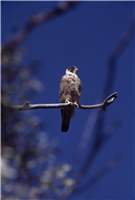Family
Falconidae
Genus
Falco
Species
longipennis
Threats/Control Methods - Regional
Widespread and continued land clearing for urban development and agriculture threatens the availability of tall trees for roosting and the necessary abundance of small mammals and birds to feed upon. Prolonged periods of drought will force this species to move into less ideal feeding areas to be close to water. The ideal surrounding habitat in this region, the Yellow Box/Red Gum Grassy Woodland is considered Endangered and only 3-4% of its original extent remains in something like its natural state.
Threats/Control Methods - Local
The dominance of more aggressive introduced species such as Common Mynas (Acridotheres tristis ), Dogs (Canis familiaris) and Cats (Felis catus) limit the availability of easily available food for this species.
Local/Urban Actions
Gardeners can encourage a wide range of species by ensuring their yard consists of a good mix of trees, shrubs and ground litter. Canberra residents can also encourage all native birds into the local region by participating in tree planting or bush regeneration activities with local Landcare groups or with Greening Australia.
Common Names
Australian Hobby, Little Falcon, White-fronted Falcon
Distinguishing Features
The Australian Hobby is a large bird 30-35cm in size with a wingspan of 70-90cm. They have a large eye and a thick, stumpy hooked beak. Their head is dark brown and their back and feathers are blue-grey. The throat and underparts are cream with brown markings. In flight, the tail is square and gently rounded. Young birds are a dark red-brown colour.
Survey Techniques
Call and visual identification
Species Call
A sharp, harsh, metallic 'kiek-kiek-kiek-kiek', speeding up to 'kikikikikiki'
Similar Species
The Peregrine Falcon (Falco peregrinus) and the Nankeen Kestrel (Falco cenchroides) are very similar looking birds of prey, however they have yellow around the eye and beak. The Falcon is much larger and the Kestrel is lighter in colour.
Distribution
The Australian Hobby is found right across Australia and TAS, however nowhere in high abundance.
Country of Origin
Australia
Conservation (Pet/Pest) Status - Regional
The population numbers have decreased significantly since 1981, however are now stable (COG).
Conservation (Pet/Pest) Status - National
Secure, not listed under the EPBC Act 1999. The species is widely distributed, however in sparse numbers.
LSCCES Population
The species was found in low numbers at the NMA and one was seen at ANU.
Associated vegetation community
This species will survive in most areas and is especially found in open woodland and grassland areas, open forest, heath, farmland and garden suburbs.
Limiting Resources
The Hobby depends on a good water source and is often found near lakes and swamps. They also require tall trees for nesting and a reliable supply of a range of smaller species for food.
Breeding
The breeding season in the Canberra region is fairly predictable, with male displays in October, nesting activities from November to January and dependant young in February. The Hobby will use the nest of another bird or prey, made of twigs and leaves and placed high in tall trees. The female incubates the 2-4 eggs, which are large and cream with many red-brown speckles. The male does all the hunting in this time and when the young are first born. The young hatch in a white down and are pink-brown coloured after two weeks. Young leave the nest after 35-38 days.
Behaviour
The Australian Hobby is a fast and agile, easily overtaking prey and swooping to attack with their aerobatic skills. In flight, they use rapid wing beats with occasional glides. They are obvious in the suburban areas when perched on dead tree branches or powerlines.
Functional Group
Food Species
The superior hunting skills of the Australian Hobby allows it to catch its prey in flight, including large insects, bats and small to medium sized birds.
Predators
This species sits at the top of the food chain and instead predates other smaller birds.
Interesting Fact
The alarm calls of other small birds are one of the best ways to know an Australian Hobby is nearby.
References - (reader suitability of references, P=Primary teachers, S=Secondary students, T=Tertiary students and researchers)
Books:Morcombe, M. 2000. Field Guide to Australian Birds. Steve Parish Publishing. Archerfield. Australia P, S, T
Pizzey, G. 2000. The Graham Pizzey & Frank Knight Field Guide to the Birds of Australia. Angus & Robertson, Sydney. P, S, T
Veerman, P. 2003. Canberra Birds: A report on the first 21 years of the garden bird survey. Philip Veerman and Canberra Ornithologists Group. Canberra. S, T
Internet: Canberra Ornithological Group (COG). 2004. Birds of Canberra Gardens. COG and the ACT Department of Urban Services. [online]. Available at:http://garden.canberrabirds.org.au/ P, S, T
Online Publications:ACT Government. 2004. Woodlands for Wildlife: ACT Lowland Woodland Conservation Strategy. Action Plan No. 27. Environment ACT, Canberra. [online]. Available at: http://www.environment.act.gov.au/nativeplantsandanimals/threatecspec/woodlandsstrategy S, T
Nix, H. and Cunningham, R. 2006. Birds of the Lower Sullivans Creek Catchment, Canberra ACT. Prepared for the Life in the Suburbs project using data from the Lower Sullivans Creek Catchment Ecological Survey (LSCCES). Australian National University. Canberra. [online]. Available at: http://www.lifeinthesuburbs.com.au/category.php?id=65 S, T
Olsen, P. et al. 2005. The State of Australia's Birds 2006: Invasive Species. Supplement to Wingspan 16:4. Birds Australia. [online]. Available at: http://www.birdsaustralia.com.au/soab/SOAB2006.pdf S, T

 Top
Top Top
Top